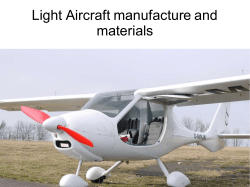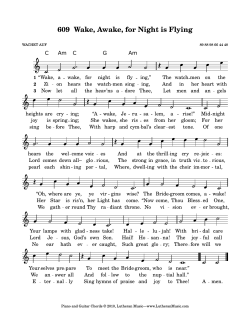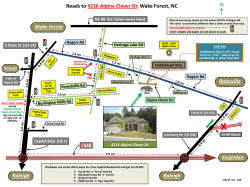
The D8 Aircraft: An Aerodynamics Study of Boundary Layer and
The D8 Aircraft: An Aerodynamics Study of Boundary Layer and Wake Ingestion Benefit! Shishir A. Pandya Applied Modeling and Simulation Branch NASA Ames Research Center AA294: Case Studies in Aircra4 Design Stanford University, CA, Apr.22, 2015 With contributions from:Arthur Huang, and Alejandra Uranga at MIT, and H. Dogus Akaydin and Shayan Moini-Yekta, Science and Technology Corporation 1 Outline • The D8 aircra4 • Previous work • Wind tunnel models and tesKng • ConfiguraKons • Mesh generaKon and flow soluKon • ValidaKon without nacelles • Boundary layer ingesKon (BLI) and benefit • Wake ingesKon and benefit 2 MIT/PraW & Whitney/Aurora D Series Airframe & Propulsion Technology Overview Novel configuraKon plus suite of airframe and propulsion technologies, and operaKons modificaKons Reduced Secondary Structure weight Active Load Alleviation High Bypass Ratio Engines (BPR 20) with High-Efficiency Small Cores Health and Usage Monitoring Boundary Layer Ingestion Distortion Tolerant Fans Tt4 Materials and advanced cooling Natural Laminar Flow on Wing Bottom Variable Area Nozzle Lifting Body Advanced Structural Materials Faired Undercarriage LDI Advanced Combustor Advanced Engine Materials 3 The D8 Aircraft Concept • “Double-Bubble” • Advanced Air Transportation Technologies (AATT) project –Fixed-wing –N+3 advanced vehicle configuration • Lower fuel burn, noise, emissions • 180 passengers • 3000 nmi range • 118 ft span • Boeing 737/A320 class • Lifting fuselage, pi-tail • Flush-mounted engines 4 B737—>D8 Our Focus: BLI B737 Slow to M=0.72 Engine! Integration Fuel Burn D8 fuselage,! Pi tail Podded! engines BLI Optimize! Engines Newer! Engines Design IteraKon 5 Lower Cruise Speed • M=0.72 –Lower wing sweep • Reduced structural load => lower weight • Increased CL • Can eliminate high-‐li4 devices M. Drela, MIT –Proper speed at engine fan face (M=0.6) • Reduces nacelle, inlet size • Reduced nacelle drag –Nacelles embedded in the π-‐tail and fuselage –Reduced size, weight 6 Fuselage Advantages • “Double-‐bubble” fuselage provides more li4 – Gives parKal span-‐wise loading / smaller wing • Shorter cabin (wider body, two isles) –Results in lighter landing gear support structure –Faster passenger loading with two isles • Provides a nose-‐up pitching moment –Shrinks horizontal tail –Lighter horizontal tail 7 Embedded Rear-‐Mounted Engines Nacelle Fan • Boundary Layer IngesKng (BLI) engines for propulsive efficiency –Thicker boundary layer in the rear –Designed for M=0.6 flow around engine inlet area –DistorKon tolerant fan –High bypass raKo (~20) • Lower engine-‐out yaw –Reduced verKcal tail size •Noise shielded by fuselage 8 Previous ComputaKonal Work • “Double-‐bubble” fuselage provides more li4 - Gives parKal span-‐wise loading / smaller wing • Thicker boundary layer in the rear - Designed for M=0.6 flow around engine inlet area • Provides a nose-‐up pitching moment - Shrinks horizontal tail - Lighter horizontal tail • ValidaKon of CFD - Mesh sensiKvity - Comparison to Experiment 9 Goals and Approach • Goal: QuanKfy benefits of boundary layer and wake ingesKon for the D8 • Overset CFD using CGT and Overflow-‐2: –CFD validaKon • NASA LaRC 14x22 WT data for a 1:11 scale model –QuanKfying the BLI and wake ingesKon benefit: • Direct Comparison between: –Efficient convenKonal (podded nacelle) configuraKon –BLI (integrated nacelle) configuraKon 10 Wind Tunnel Configurations Unpowered Integrated Podded Integrated (Close-‐up) 11 ConfiguraKon Details • WT runs at 70 mph, Re_c = 570,000 –lower-‐speed and Re compared to full-‐size at M=0.72 • 1:11 Scale powered model in the NASA LaRC 14x22 WT • Wing designed for low Mach, low Re • Same wings • Most of fuselage is the same • Same propulsors plug into both podded and integrated configuraKon empennage secKons 12 D8 Model Blue indicates regions of overlap • ComputaKonal model • Larc 14x22 WT model –1:11 scale, Half body –1:11 scale, Full body –MounKng hardware controls –No mounKng hardware AoA –Inviscid wind tunnel walls 13 Computational Configurations Unpowered Podded Integrated Integrated (close-‐up) 14 Fuselage and Wing Grids • Remain the same Integrated fuselage Unpowered and Podded 15 π-tail, Nacelle, Pylon Unpowered and Podded Integrated 16 Wind Tunnel Grids • Inviscid wall boundary condiKon • 7 grids (4 wall grids, 3 core grids) + box grids • Mach and Re number matched at pitot probe StagnaKon Pressure Loss 17 ComputaKonal Mesh • Chimera Grid Tools –Overset surface and volume mesh • Same grids for forward fuselage, wing, and WT –Unpowered: 36 grids, 113 Million points –Podded: 49 grids, 130 Million points –Integrated: 64 grids, 135 Million points –y+ ≈ 0.7 18 CFD Solver • OVERFLOW –3D, RANS solver for overset structured grids –Diagonalized approximate factorizaKon Scheme –2nd order central difference + arKficial dissipaKon –Matrix dissipaKon –RANS SST turbulence model • Flow CondiKons –Mach=0.088 –Re = 44000/in. 19 Fan Model and its Effect • Actuator disk –Uniform pressure jump • Four cases with increasing pressure jump serngs • For both podded and integrated • Integrated sees a lower mass flow Podded Cuts through propulsor centerline. Integrated 20 Typical Convergence Force/Moment History Total Lift Coefficient 1 data •IteraKons to match Mach & Re at pitot probe 0.8 Total Lift Coefficient •SimulaKons without fans •Alpha sweep •Compare to Wind Tunnel test total CL Total 0.6 0.4 0.2 0 0 20 k 40 k 60 k 80 k Time Step Number 100 k 21 120 k Validation-unpowered 0.0700 14x22 WT Overflow2 1.2 14x22 WT Overflow2 0.0650 0.0600 0.0550 1 CD CL 0.0500 0.8 0.0450 0.0400 0.0350 0.6 0.0300 0.0250 0.4 0 2 4 α 6 8 0.0200 14x22 WT Overflow2 0 1.2 2 4 8 6 α 14x22 WT Overflow2 L/D=20 0.1 1 CM CL 0 0.8 -0.1 -0.2 -0.3 0 Simulated Cruise 0.6 2 4 α 6 8 0.4 0.02 0.03 0.04 CD 0.05 0.06 0.07 22 Propulsor Inlet Flow Comparison Integrated ConfiguraKon AOA=2° 14x22 WT Overflow 23 Propulsor Exit Flow Comparison Integrated ConfiguraKon AOA=2° 14x22 WT Overflow 24 Effect of MounKng Hardware 0.0700 14x22 WT Overflow2 - no Struts Overflow2 - with HWstruts Overflow2 - with all Struts 1.2 14x22 WT Overflow2 - no Struts Overflow2 - with HW Struts Overflow2 - with all Struts 0.0650 0.0600 0.0550 1 CD CL 0.0500 0.8 0.0450 0.0400 0.0350 0.6 0.0300 0.0250 0.4 0 2 4 α 6 8 0.0200 0 2 4 α 6 8 25 Boundary Layer Ingestion • ConvenKonal: wake/BL energy lost ! Wasted Kinetic Energy Zero Net Momentum − ! wake, or "draft" + propulsor jet + + • BLI: Fuselage boundary layer ingested by propulsor –> Reduced viscous dissipaKon in − combined w + ake + jet + from propulsor + –> Reduced flow power required Wasted Kinetic Energy Zero Net Momentum − + combined wake and jet + − + + wake, or "draft" propulsor jet ! − + combined wake and jet + − + + ! • Use Power-‐balance method (Drela, 2009, AIAA J.) 26 Power Balance Method • Mechanical energy sources and sinks –Sinks: Boundary layer, Wake –Source: Jet ! ! ! ! ! ! • Power-‐in (PK) = DissipaKon (Φ) • Compute dissipaKon: upstream of the surface of interest, and downstream mixing 27 BLI Benefit • Compare mechanical flow power: ! –Power transmiWed by propulsor to the flow • Savings in power required: integrated vs. podded Integrated (BLI) Podded (non-‐BLI) 28 CompuKng BLI Benefit • Mechanical flow power ! ! • Net axial force: pressure force + viscous force. –On airframe solid surfaces + actuator disk • Compare podded and integrated configs –At cruise condiKon • Net axial force = 0 • Drela, 2009 “PowerBalance in Aerodynamic Flows”. 29 Net Axial Force Coefficient Benefit of BLI (ComputaKonal) Mechanical Flow Power Coefficient 30 Where is the Benefit Coming From? Podded • IdenKfy sinks of power –Upstream viscous dissipaKon Wake Fuselage TE Inlet Integrated • measured by stagnaKon pressure flux • We can focus on stagnaKon pressure loss and dissipaKon 31 Inlet Unpowered Podded 32 Inlet (cont.) Podded Integrated 33 Wake Unpowered Podded 34 Wake (cont.) Podded Integrated 35 Fuselage Trailing Edge Unpowered Podded 36 Fuselage Trailing Edge (cont.) Podded Integrated 37 Viscous DissipaKon DissipaKon , Mechanical Flow Power • DissipaKon coefficient: 38 DissipaKon ComputaKon Fuselage Region Podded Nacelle Region Wing Wake Region • DissipaKon computed in each region –No separate nacelle for integrated config 39 DissipaKon at Inlet • Minor variaKons in fuselage and wing regions. • Only major difference due to presence of podded nacelle. 40 DissipaKon in the Wake • Wing dissipaKon not affected by BLI • Integrated config. has 6% less overall dissipaKon –3/4 from lower jet velocity –1/4 from lower fuselage/nacelle dissipaKon 41 Flow SeparaKon 42 Wake IngesKon • Previous podded nacelle almost ingested the wing wake • Can we move the nacelle out of the way? • What is the effect of nacelle movement on BLI? Baseline: WT test model 43 Test Matrix • • • • • • Deflect the nacelle up and down (-‐20°,-‐10°,0°,10°,20°,30°) Power serng: closest to WT test serng Keep the outboard posiKon and toe angle unchanged Compare to the baseline case Δ=D1-‐D0=D0(1/cos θ-‐1) Translate by Δ, then rotate by θ 44 Stagnation Pressure Loss (φ=0°) prior to entering the nacelle 45 Stagnation Pressure Loss (φ=30°) prior to entering the nacelle 46 Stagnation Pressure Loss (φ=-20°) behind the nacelle 47 Effect of Pylon DeflecKon 0.645 CL 0.64 0.5% 0.635 0.63 30 φ = −20 φ = −10 φ= 0 φ = 10 φ = 20 φ = 30 40 50 60 70 Power Setting 80 90 100 110 Lift 48 Effect of Pylon DeflecKon 0.047 0.046 0.045 CD 1.6% 0.044 φ = −20 φ = −10 φ= 0 φ = 10 φ = 20 φ = 30 0.043 0.042 30 40 50 60 70 Power Setting 80 90 100 110 Drag 49 Effect of Pylon DeflecKon 0.025 φ = −20 φ = −10 φ= 0 φ = 10 φ = 20 φ = 30 0.02 Net Axial Force Coefficient 0.015 0.01 0.005 Largest change: 0.003 (0.8%) 0 -0.005 -0.01 -0.015 -0.02 -0.025 0.02 0.04 0.06 Mechanical Flow Power Coefficient 0.08 Axial Force vs. Mech. Flow Power with power settings of 40, 60, 80 and 100% 50 Concluding Remarks • BLI benefit is: –9% less Mechanical flow power with BLI • Wake ingestion benefit is: –0.8% less Mechanical flow power with wake ingestion • BLI has the potential to reduce fuel burn • Wake Ingestion is not worth pursuing • Future Work: –Full scale aircraft at cruise Ma, and Re. –Other operating conditions –Improve actuator disk model 51 Current and Future Work • Mesh study for integrated configuraKon • Turbulence model study • MounKng hardware study • BLI benefit at M=0.72, 0.8 at high Re • Improvements to the D8 design? 52 Acknowledgments • Thanks also go to: MIT •Mark Drela •Ed Greitzer •and the D8 team NASA (ARC & LaRC) •William Chan •Greg Gatlin •Judith Hannon •Pieter Buning •Tom Pulliam Project •Nateri Madavan •Scott Anders •Sally Viken •Rich Wahls •Ruben Del Rosario •Mike Rogers •John Koudelka 53
© Copyright 2025









